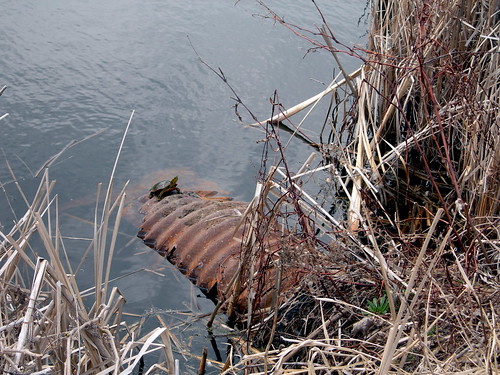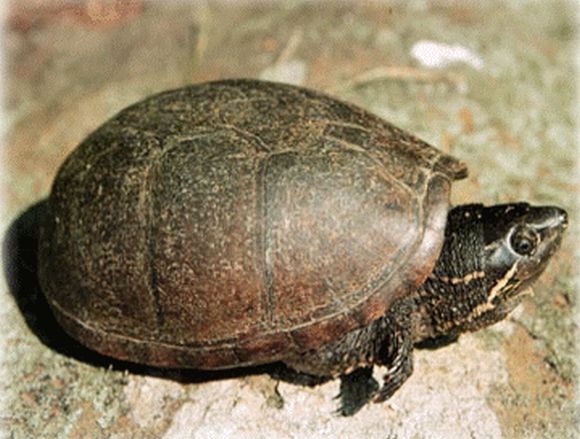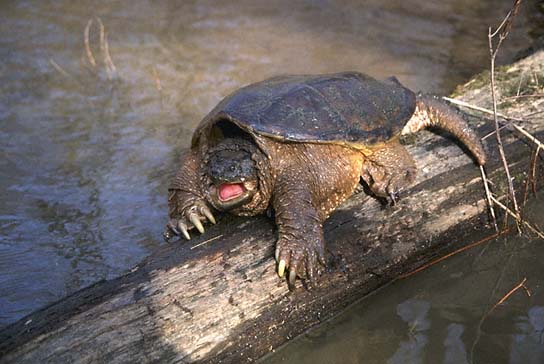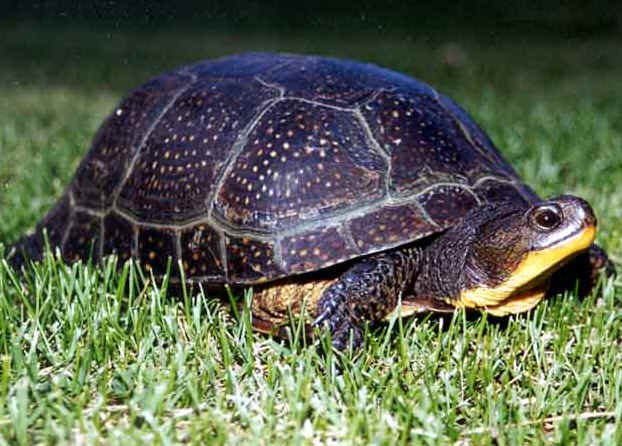
10:44 p.m. - 2005-04-14
Minnesota's State Reptile.
Dear Readers,
Happy Wednesday to you! I hope you're enjoying the beauty of springtime. In this very spirit of spring exploration R and I took a walk this Sunday! And it was a fruitful journey. We took a set of binoculars to the smaller marsh in Northern Richfield, adjacent to K and A B's house. (Where I was cat-sitting "Pepe".)
The city of Richfield should add to its official title: City of Muskrats. For indeed, R and I observed two of them! The first muskrat was large and robust. It was grooming itself, which was very cute. The second muskrat was much smaller, perhaps four or five inches long. It was sitting in some reeds, eating. With the binoculars we could see that muskrats hold their food like humans who are eating corn on the cob. Except muskrat teeth are bright orange! It was also very cute. The little muskrat would dive, and reappear with the root, or whatever it was eating.
We also saw ducks, geese (including one who hissed at us!) and a random dude sleeping on a bench!
And...we saw Minnesota's State Reptile! Well, we saw a turtle sunning itself. Blanding's turtle (Emydoidea blandingii) holds the actual title. I've never heard of this species, have you guys?
Wendell loves turtles. My family lives across the street from a lake, and one afternoon after a rainstorm, we were walking over there on the sandy bank, and saw about ten female turtles in the various stages of digging holes and laying eggs! I was about twelve, and was fascinated.
Visions of "Nature" episodes appeared in my mind: the nighttime scenes of all the baby sea turtles racing down the beach to the ocean! This prompted me to dig up some turtle eggs and put them in a sand-filled bucket in my backyard. Not recommended.
Anyway, it was then that I added a third type of turtle to the pair (Painted and Snapping turtles)with which I was familiar: the Musk turtle (Sternotherus odoratus). (Hmmm, they more common in WI, yet "not absent" from MN, according to one website....)
Musk turtles excrete an orange-colored smelly liquid on the underside of their shell when they are bothered. Their shells are domed and drab-colored and their heads are thick (like a snapping turtle head).
Painted turtles (Chrysemys picta) are probably the most commonly seen turtles. Their carapaces are flatter than the musk turtle, and their underside (plastron) is orange or yellow, with a sort of patterned "border" on the edge of its shell. Painted turtle heads are narrow and thinner than the snapping and musk turtles.
And I'm sure you've seen a snapping turtle (Chelydra serpentina)! These reptiles are made unmistakable by the points on their carapace! They are usually the largest turtles seen, and tend to be aggressive on land. Snapping turtles are aptly named; even in death their jaws stay clamped!
Blanding's turtle is protected in MN. It has a domed, spotted shell, yellow neck, and is located throughout central and southeast parts of the state. Wabasha county boasts the most sightings of Blanding's turtle. They are especially prevalent at the Weaver Dunes. It seems like Blanding's turtles are endangered because they need a larger range in which to breed, spend the summer and hibernate in the winter. They are also remarkable for having a long life span. A 75 year old female is the oldest known Blanding's turtle, and apparently this female produced egg broods for 60 years!
Turtles are ready for mating at about five years of age or so. The mating dance occurs during the spring and eggs are laid in May. (But females can store sperm for later use.) Egg-laying is one of the most dangerous times for females as they often have to travel across roads to find appropriate digging spots. Two months later, the eggs hatch, and the return trip for the babies is equally dangerous.
Often the only sign of turtle babies (with shells the size of a quarter or less!) are discarded shells near a hole! To help identify what turtles were born there, I'll review the turtle egg characteristics I remember from back in the day. Painted turtle eggs have soft oblong shells, which sort of curl up like leather bits. The next two leave shells more easily recognizable as broken eggs. Musk turtles eggs are hard and oblong and snapping turtles have hard, round eggs, the size of a pingpong ball.
In and around water, turtles eat both plant life and animals, including small fish (Snapping turtles eat birds, frogs, and even muskrats! Watch out, dudes!) and also scavenge from the shoreline. (I don't know about land-lubbing box turtles; I've never seen one and I'm pouting about that.)
The history of turtles is fascinating. They pre-date mammals, lizards and birds, with a fossil record dating back 200 million years! In Nebraska shell fragments 5.5 million years old were positively identified as a Blanding's turtle.
So, the next time you see one of our turtle-y friends, think about how much change its ancestors have witnessed for the last 200 million years!





